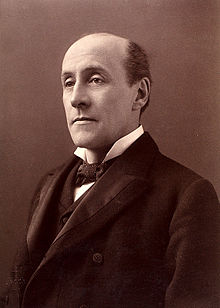Anthony Hope
| Sir Anthony Hope Hawkins | |
|---|---|

Photo of Sir Anthony Hope Hawkins by Alfred Ellis & Walery
|
|
| Born |
9 February 1863 Clapton, London |
| Died | 8 July 1933 (aged 70) Walton-on-the-Hill, Surrey |
| Nationality | British |
| Other names | Anthony Hope |
| Occupation |
Barrister Writer |
| Notable work |
The Prisoner of Zenda Rupert of Hentzau |
Sir Anthony Hope Hawkins, better known as Anthony Hope (9 February 1863 – 8 July 1933), was an English novelist and playwright. He was a prolific writer, especially of adventure novels but he is remembered predominantly for only two books: The Prisoner of Zenda (1894) and its sequel Rupert of Hentzau (1898). These works, "minor classics" of English literature, are set in the contemporaneous fictional country of Ruritania and spawned the genre known as Ruritanian romance.Zenda has inspired many adaptations, most notably the 1937 Hollywood movie of the same name.
Hope was educated at St John's School, Leatherhead, Marlborough College and Balliol College, Oxford. Hope trained as a lawyer and barrister, being called to the Bar by the Middle Temple in 1887. He served his pupillage under the future Liberal Prime Minister H H Asquith, who thought him a promising barrister and who was disappointed by his decision to turn to writing.
Hope had time to write, as his working day was not over full during these early years and he lived with his widowed father, then vicar of St Bride's Church, Fleet Street. Hope's short pieces appeared in periodicals but for his first book he was forced to resort to a self-publishing press. A Man of Mark (1890) is notable primarily for its similarities to Zenda: it is set in an imaginary country, Aureataland and features political upheaval and humour. More novels and short stories followed, including Father Stafford in 1891 and the mildly successful Mr Witt's Widow in 1892. He stood as the Liberal candidate for Wycombe in the election of 1892 but was not elected. In 1893 he wrote three novels (Sport Royal, A Change of Air and Half-a-Hero) and a series of sketches that first appeared in the Westminster Gazette and were collected in 1894 as The Dolly Dialogues, illustrated by Arthur Rackham.Dolly was his first major literary success. A.E.W. Mason deemed these conversations "so truly set in the London of their day that the social historian would be unwise to neglect them," and said that they were written with "delicate wit [and] a shade of sadness."
...
Wikipedia
